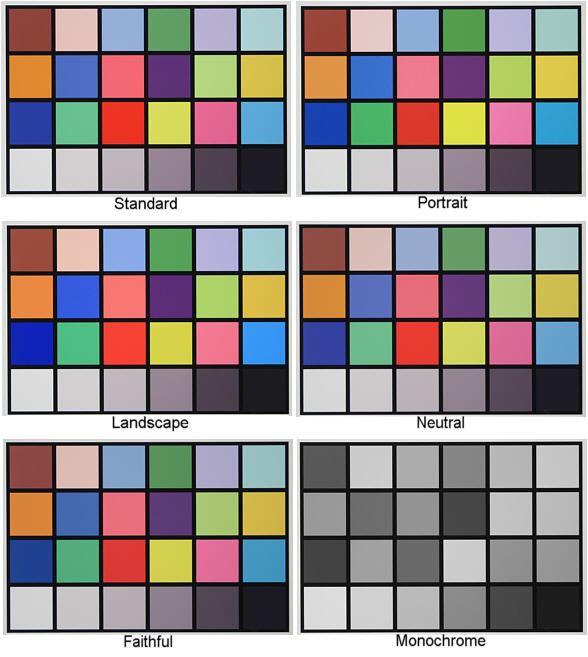
|
Canon EOS 30D - Hands-on Review
Picture StylesCanon have added the Picture Styles mode to the EOS 30D. It's also available on the EOS 5D and EOS 1D Mk II N. Canon likens the effects of the picture style modes to the ability to use different types of film in film cameras. The various settings are optimized for various effects and applications, with different settings for contrast, sharpness, saturation and color tone as well as some differences in color mapping and curves which aren't documented.
In addition to the predefined Picture Styles, there are 3 user settable modes in which Sharpness, Contrast, Saturation and Color Tone can be set (as they can with the EOS 20D as described below). Here are examples of the various picture styles. Differences are subtle, but real. Note these images are NOT of the standard Macbeth color chart (though the color patches are similar) so don't try to gauge absolute color accuracy from them.
It's probably easier to see difference in the following image, which shows samples from the third row of each color image side by side:
The EOS 20D doesn't have built in Picture Styles, but the same (or similar) effects can be obtained in two different ways. If you shoot in RAW mode rather than JPEG, the RAW converters in the Canon software (DPP and Zoombrowser) allow the Picture Styles to be emulated during the RAW conversion - though the RAW converters in DPP and Zoombrowser may give slightly different results. Applying Picture Styles during RAW conversion is also possible with 30D RAW images of course, the Picture Styles are only directly applied to images saved as JPEGs (though the Picture Style settings are recorded along with RAW images and would be used by default). The 20D also has 3 sets of user settable parameters (user1, user2 and user3), as well as two presets (parameter1 and parameter 2). "Parameter 1" is close to the "Standard" Picture style with slightly higher contrast, saturation and sharpness.
These are the default parameter settings for the 30D Picture Styles
Note that there are "hidden parameters" in the Picture styles since the "Neutral" and "Faithful" settings use exactly the same Sharpness, Contrast, Saturation and Color Tone settings, yet they do yield slightly different results, plus the "Standard", "Portrait" and "Landscape" modes differ only in their sharpness settings, yet again yield images which differ in color rendition as shown above. So "Picture styles" are more than just preset values of sharpness, contrast, saturation and color tone. NEXT -> Viewfinder and Metering
© Copyright Bob Atkins All Rights Reserved |
||||||||||||||||||||||||||||||||||||||||||||||||||||||||

